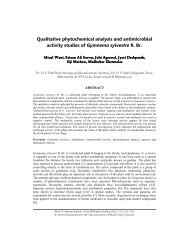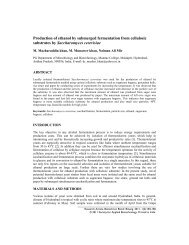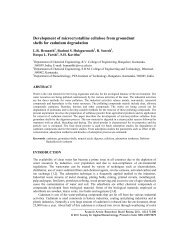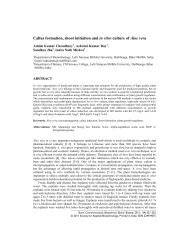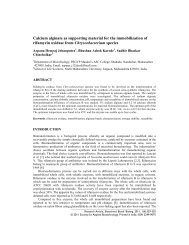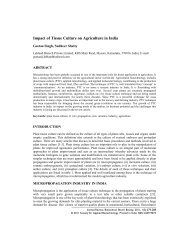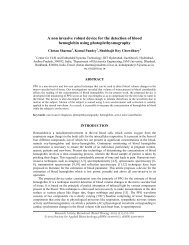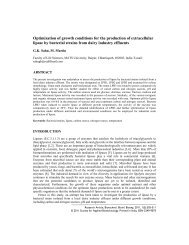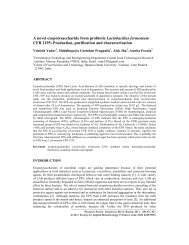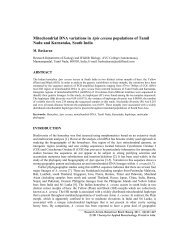Agrobacterium mediated transformation and regeneration of ...
Agrobacterium mediated transformation and regeneration of ...
Agrobacterium mediated transformation and regeneration of ...
Create successful ePaper yourself
Turn your PDF publications into a flip-book with our unique Google optimized e-Paper software.
<strong>Agrobacterium</strong> <strong>mediated</strong> <strong>transformation</strong> <strong>and</strong> <strong>regeneration</strong> <strong>of</strong><br />
Cauliflower (Brassica oleraceae var. botrytis)<br />
Ashwini Kumar Ray 1 , Ashish Kumar Choudhary 1 ,<br />
S<strong>and</strong>hya Jha 2 , Indranath Mishra 1<br />
1 Department <strong>of</strong> Biotechnology, LN Mithila University, Darbhanga, Bihar 846004,<br />
India; Email: indralnmu@rediffmail.com; 2 Department <strong>of</strong> Botany, C.M. Science<br />
College, Darbhanga, Bihar 846004, India<br />
ABSTRACT<br />
Cotyledons <strong>and</strong> hypocotyls as an explants <strong>of</strong> in vitro aseptically grown seedlings <strong>of</strong> cauliflower were taken <strong>and</strong><br />
inoculated with A. tumefaciens strain LBA 4404 harboring a binary vector pbin Bt3 <strong>of</strong> size 12.60 Kb.<br />
The T-DNA <strong>of</strong> plasmid pbin Bt3 contains a Neomycin Phosphotransferase-Il gene (nptll) for<br />
kanamycin resistance, under Nopaline Synthase gene (NOS) promoter, <strong>and</strong> a Cry-1A(c) gene which is<br />
for developing insect resistant. Explants were transformed <strong>and</strong> regenerated on MS basal Media. The<br />
different concentration <strong>of</strong> BAP (benzyl aminopurine) was used with MS basal media for the <strong>regeneration</strong> <strong>of</strong><br />
transformed explant. The concentrations <strong>of</strong> BAP used were 0.2, 0.5 <strong>and</strong> 1.0 mg/L. Although a little bit<br />
callusing was observed on all the three BAP concentrations, but better <strong>regeneration</strong> was found from explants<br />
cultured on the media supplemented with 0.5 mg/L.<br />
Keywords: <strong>Agrobacterium</strong>, <strong>regeneration</strong>, <strong>transformation</strong>, Cry-1A(c) gene, explant<br />
INTRODUCTION<br />
Brassica oleraceae is a diverse group which includes many important vegetable crops; cauliflower<br />
is one <strong>of</strong> its important members. Due to its large nutritional value it is grown world wide in many<br />
countries like US, Italy, France, China <strong>and</strong> India (www.prota.org). Annual world production <strong>of</strong><br />
cauliflower was over 12.7 million metric tons in 1996, with China leading with more than 30% <strong>of</strong><br />
world production. But due to insect pest invasion the estimated loss is about 20-30% [1]. It is easily<br />
attacked by Lepidoptera pest such as Plutella xylostella <strong>and</strong> Pieris rapae. Chemical insecticide can<br />
reduce loss but residual chemical are harmful to human <strong>and</strong> ecosystem. Massive quantities <strong>of</strong><br />
insecticides are used especially in mid <strong>and</strong> late-season crop in the north Indian plains where<br />
incidence <strong>of</strong> pests is high.<br />
Traditional breeding methods have significantly enhanced productivity <strong>and</strong> quality <strong>of</strong> the crop,<br />
but insect-pests, for which no source <strong>of</strong> resistance is available, continue to cause severe damage.<br />
Environment <strong>and</strong> health concerns associated with the use <strong>of</strong> pesticides call for alternative methods<br />
<strong>of</strong> pest control. Hence genetic engineering experiments have to be undertaken so as to produce more<br />
ecologically <strong>and</strong> economically viable traits. Currently the most widely used method for transferring<br />
genes into the plants are A. tumefaciens <strong>mediated</strong> transfer [2] <strong>and</strong> the particle bombardment mainly<br />
for monocots [3], which involves a device called as gene gun, particle gun or microprojectile in<br />
which the gene to be introduced into the plant cells is coated as to tiny metal particle like gold <strong>and</strong><br />
tungsten <strong>and</strong> then physically shot on to target cells.<br />
Research Article, Biotechnol. Bioinf. Bioeng. 2012, 2(1):580-583<br />
© 2012 Society for Applied Biotechnology; pISSN 2249-9075, eISSN 2249-9938
Biotechnol. Bioinf. Bioeng. 2012, 2(1):580-583<br />
MATERIALS AND METHODS<br />
In vitro grown explant<br />
Cauliflower seeds were surface sterilized with sodium hypochlorite along with 5% cetrimide for 5-<br />
10 min after treatment with fungicide (Bavistin), rinsed with distilled water <strong>and</strong> placed over<br />
germination media <strong>of</strong> half strength MS [4]. The pH <strong>of</strong> media was set to 5.9 before autoclaving at<br />
120 0 C for 20 min. Cotyledons <strong>and</strong> hypocotyl were cut from in vitro grown 4, 6, 10, 15, 20 days old<br />
seedlings.<br />
Strains <strong>and</strong> plasmid<br />
<strong>Agrobacterium</strong> strain LBA 4404 harboring a binary vector pbin Bt3 <strong>of</strong> size 12.60 Kb. The T-<br />
DNA <strong>of</strong> plasmid pbin Bt3 contains a Neomycin Phosphotransferase-Il gene (nptll) for<br />
kanamycin resistance, under Nopaline Synthase gene (NOS) promoter, <strong>and</strong> a Cry 1A(c) gene<br />
which is for developing insect resistance, was used.<br />
Transformation<br />
500 ml <strong>of</strong> the overnight grown log phase culture <strong>of</strong> A. tumefaciens was used. The flask was<br />
agitated at 65 rpm, at 28°C, for either 30 min or 1 hr. The explant was co-cultured with<br />
overnight grown log phase culture <strong>Agrobacterium</strong>. After the period <strong>of</strong> incubation, the<br />
bacterial suspension was drained out. The explants were then blotted dry using a sterile tissue<br />
paper <strong>and</strong> co-cultivated on co-cultivation medium for 4-6 days. After co-cultivation, explants<br />
were washed three times with sterile distilled water. After this the explants were subjected to MS<br />
medium containing carbenicillin (500mg l -1 ) to prevent overgrowth <strong>of</strong> <strong>Agrobacterium</strong> for 6-7 days.<br />
If the carbenicillin alone was not sufficient to control bacterial growth then carbenicillin (500 mg l -<br />
1 ) was used in combination with cephotaxime (250 mg l -1 ).<br />
RESULTS AND DISCUSSION<br />
In vitro grown explants<br />
Seedling explants <strong>of</strong> Cauliflower are best for in vitro <strong>regeneration</strong>. Usually these explants are<br />
obtained from sterile in vitro germinated seedlings. Before germination, the seeds were surface<br />
sterilized <strong>and</strong> the different treatments used for the surface sterilization <strong>and</strong> their results are given in<br />
the table 1. Sprouting <strong>of</strong> the seeds usually starts after 3 days <strong>of</strong> inoculation. Contamination usually<br />
appears on an average after 5 to 7 days, if any. Among all the protocols followed the best protocol<br />
was A 5 followed by A 1 in terms <strong>of</strong> germination as well as sterilization (Table 1). After proper<br />
sterilization seed were grown on half strength MS medium [4].<br />
Regeneration from hypocotyls <strong>and</strong> cotyledons<br />
For the <strong>regeneration</strong>, hypocotyls <strong>and</strong> cotyledons explants from in vitro grown seedlings used. The<br />
different concentration <strong>of</strong> BAP (benzyl aminopurine) was used with MS basal media for the<br />
<strong>regeneration</strong>. The concentrations <strong>of</strong> BAP used were 0.2 mg/L, 0.5 mg/L <strong>and</strong> 1.0 mg/L. The explants<br />
were sub-cultured after 15 days. Although a little bit callusing was observed on all the three BAP<br />
concentrations, better <strong>regeneration</strong> was found from hypocotyls explants cultured on the media<br />
supplemented with 0.5 mg/L. This result is comparable to the result <strong>of</strong> Bhalla <strong>and</strong> Smith, who found<br />
that hypocotyl explants expressed the highest adventitious bud <strong>regeneration</strong> capacity [5]. Bhalla <strong>and</strong><br />
581
Biotechnol. Bioinf. Bioeng. 2012, 2(1):580-583<br />
Smith tested hypocotyls, cotyledon <strong>and</strong> root explants <strong>of</strong> the eleven Australian cauliflower genotypes<br />
<strong>and</strong> found that the root <strong>and</strong> hypocotyl explants were more responsive to shoot <strong>regeneration</strong> than that<br />
<strong>of</strong> cotyledon explants [6]. Cytokinin is the most critical phytohormone group for stimulating bud<br />
organogenesis from cauliflower explants. The optimum cytokinin concentration varies with<br />
genotype <strong>and</strong> explant types. On cytokinin containing shoot induction (<strong>regeneration</strong>) medium, callus<br />
develop from the explants. Adventitious buds subsequently develop from the callus. Shoot<br />
elongation <strong>and</strong> rooting <strong>of</strong> cauliflower adventitious buds can occur on basal medium without<br />
hormonal supplement. However, some workers used specific media for shoot elongation/rooting<br />
stages (Figure 1).<br />
(a)<br />
(b)<br />
(c)<br />
Figure 1. (a) In vitro germination <strong>of</strong> Cauliflower seed on half strength MS medium; (b) Cotyledon<br />
explants in <strong>regeneration</strong> medium with 50 mg/ml kanamycin; <strong>and</strong> (c) Hypocotyl explant in <strong>regeneration</strong><br />
medium with 50mg/ml kanamycin.<br />
582
Biotechnol. Bioinf. Bioeng. 2012, 2(1):580-583<br />
Table 1. Cauliflower seeds treated with different concentration <strong>of</strong> antimicrobial substances at<br />
various time periods.<br />
Experiment Bavistin Sodium hypochlorite 0.1% DS SI SG Germination<br />
number<br />
% Time<br />
(min.)<br />
5%<br />
Cetrimide<br />
HgCl 2<br />
(min.)<br />
%<br />
A 1 + 5.0 10 + - 3 405 308 76.00<br />
A 5 + 20.0 5 + - 3 198 155 78.00<br />
A 9 + 7.5 5 + - 3 105 - -<br />
A 2 - 10.0 30 - - 7 98 54 55.00<br />
A 3 - 20.0 15 - - 6 92 56 60.46<br />
A 4 - 20.0 30 - - - 65 - -<br />
A 10 + 5.0 5 + 3 3 108 - -<br />
A 6 + 20.0 5 + 3 3 195 120 61.53<br />
A 7 - 10.0 5 + 5 7 68 - -<br />
A 8 - 10.0 5 + 10 3 69 - -<br />
DS: Days <strong>of</strong> sprouting; SI: Seeds inoculated; SG: Seeds germinated.<br />
Transformation<br />
Agrobactrium-<strong>mediated</strong> <strong>transformation</strong> <strong>of</strong> hypocotyl <strong>and</strong> cotyledon explants was carried out using<br />
the <strong>Agrobacterium</strong> strain LBA 4404. This Agrobacerium harbours the binary vector pbin Bt3 <strong>of</strong><br />
12.60kb containing the Cry 1A(c) gene. For the <strong>transformation</strong>, explants first kept on a preculturing<br />
medium for 2-5 days. The preculturing medium was supplemented with BAP 1 mg/L <strong>and</strong> Kinetin<br />
0.5 mg/L. The explants were co-cultured with the <strong>Agrobacterium</strong> strain for 2 days, <strong>and</strong> then they<br />
were washed with the washing media (MS media without sucrose <strong>and</strong> agar). After washing the<br />
explants were cultured on selection media containing Kanamycin (50 mg/L) for selection <strong>of</strong><br />
transformed explants. During the process <strong>of</strong> selection the successfully transformed explants were<br />
able to grow whereas the non-transformed explants failed to grow. Most <strong>of</strong> the successful<br />
cauliflower <strong>transformation</strong> reports were based on <strong>Agrobacterium</strong>-<strong>mediated</strong> <strong>transformation</strong> <strong>of</strong><br />
seedling explants using binary plasmid [5,7]. It was found that explants from 4-day old seedlings<br />
were better than from 7- to 14-day old seedlings, as very few green shoots recovered when older<br />
seedlings were used [6]. They used hypocotyls <strong>and</strong> cotyledon explants for the <strong>transformation</strong>.<br />
Although the hypocotyls produced as many as twice the number <strong>of</strong> shoots per explant compared to<br />
cotyledon explants, higher numbers <strong>of</strong> transformed plants were obtained from cotyledon explants<br />
(Figure 1). They have concluded that cotyledon from young seedling was the best target for<br />
<strong>transformation</strong> <strong>of</strong> cauliflower; presumably such explants are more amenable to genetic<br />
<strong>transformation</strong>. Of course, such claim has to be confirmed by other workers too.<br />
REFERENCES<br />
[1] Estruch JJ, Carozzi NB, Desai N, et al. Nat. Biotech. 1997, 15:137-141.<br />
[2] Chilton MD, Drummond MH, Merlo DJ, et al. Cell 1997, 11:263-271.<br />
[3] Klein TM, Wolf ED, Wu R, Sanford JC. Nature 1987, 327:70-73.<br />
[4] Murashige T, Skoog F. Physiol. Plant. 1962, 15:473-498.<br />
[5] Ding LC, Hu CY, Yeh KW, Wang PJ. Plant Cell Rep. 1998, 7:854-860.<br />
[6] Bhalla PL, Smith N. Mol. Breed. 1998. 4:531-541.<br />
[7] De Block M, Brouwer D, De Tenning P. Plant Physiol. 1989, 91:694-701.<br />
583



